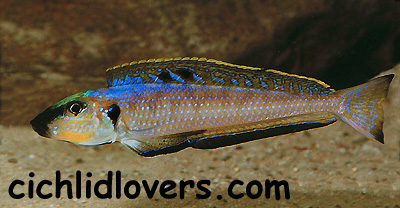|
|
||
  |
Enantiopus melanogenys
The male's nest is about 2 feet long. Melanogenys use a fine beach like sand for building their nests. I've found the best sand is "play sand" found at most any hardware store. Notice how he digs a big crater around the outer edges of the nest with the bigger pieces of sand, and places the finest sand in the center of the nest which is the spawning site.
During spawning, the nest is the male's territory and males will build their nests right next to one another. Males will meet at the edges of their territories and spar with one another. It's mostly all bluff and show, rarely do we ever see a split fin. Multiple males can be kept in the breeding tank with no harm. In fact it's better to keep multiple males in the breeding tank, otherwise we won't see their fantastic colors and behavior. After the males meticulously construct their nests, they begin courting the females who swim above the males. Rival males are chased away with all the fins erect, but the females are seduced into the nest with all the fins clamped, the throat area extended and he lies almost completely on his side, showing his colors to the ripe females above. That's just a small part of an elaborate courtship ritual of this fascinating species.
The male may spawn with many females in one day, and the female may have her eggs fertilized by two or three different males in one spawn. Clutch sizes range from 20-70 small eggs per spawn. Trade Name: "Xenotilapia Melanogenys" Distribution: Found all over Lake Tanganyika. Max size: Males 6", females 5". Sex differences: Mature males have the color, juveniles and females are plain silver. Males come in color when courting females, in captivity that's just about all their waking hours. Habitat: Sandy substrate. Best to have few other ornaments in their tank but sand. These fish dart around very fast and can injure themselves on rocks and other ornaments in the tank. Sand or gravel is not needed to induce and have successful spawning. It is however much more interesting. Sand must be kept very clean or they will not dig and build nests with it. Best to use only 1-2 inches of sand and no more. The bottom layer of sand can foul very easy if it's to deep. Food: Invertebrates filtered from the sand but in captivity will eat just about anything offered. Will accept just about any dry foods but prefers large amounts of meaty foods. Behavior: Very peaceful cichlid with an elaborate courtship ritual. Maintenance: Not aggressive to any other fishes for that reason it's hard to find any suitable tank mates that will not intimidate them to the point of showing no colors or even death. Best kept in a species specific tank. I have found plecos make the best tank mates. But other less aggressive cichlid or even community type Tropicals may be kept with them, such as Cyprichromis, Cyathopharynx etc. Best kept in in a 3'+ long tank with a tightly closed top (extreme jumpers) and few ornaments but sand. A sensitive fish to environmental changes (does not like to be moved very much and does not like extreme water temperature fluctuations), poor water quality, ich and hole in the head disease. Special care has to be taken when transporting. Additional breeding comments : Polygamous mouthbrooder. The fry are not cared for and will be eaten immediately if released in the breeding tank. Very fast developing and growing fry. Fry must be raised in very clean water and fed 2-3 times a day, and are susceptible to derogation of water quality and ich. Takes only about one year for sexual maturity to be obtained. Comments: One of the most exotic and fascinating cichlids available. Well worth the little extra bit of effort to keep them happy.
Home Availability List |
        |
|
Banner is of Malawi National Park by Pam
Chin |
||

